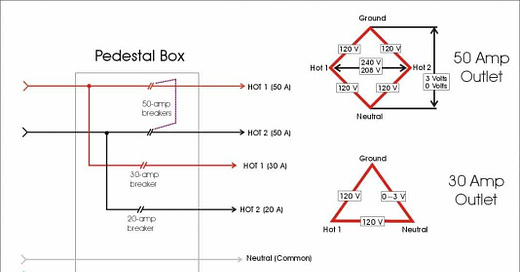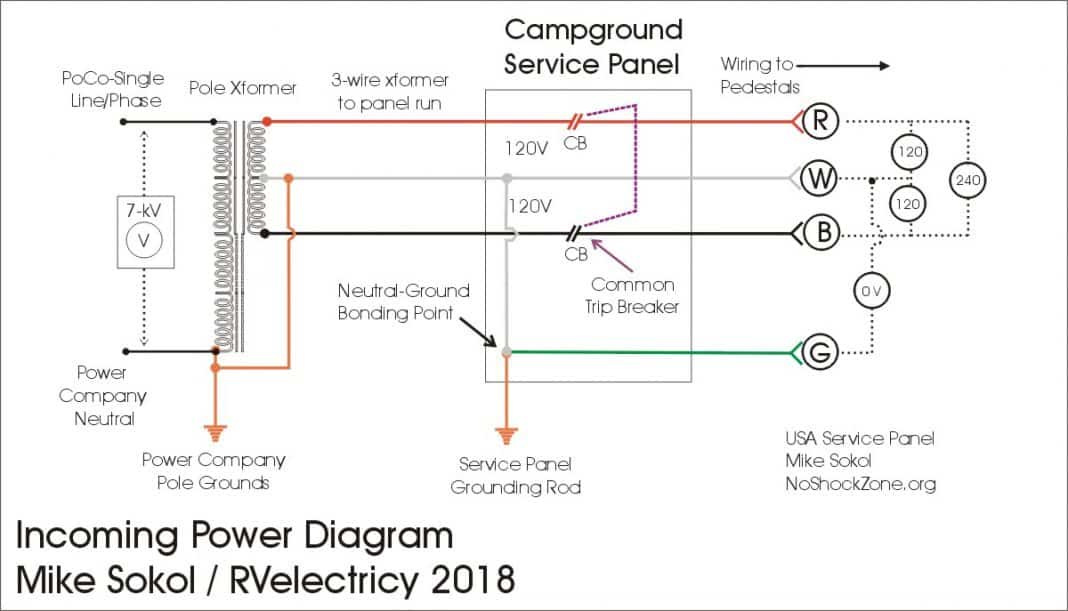Dangerous 30-amp outlet wiring!
Be sure you understand pedestal connections before doing any wiring…
Mike,
Thank you for saving my life, literally!
I have been to many of your seminars at the Hershey and Tampa RV shows. I always learn at least 1 thing new every time I attend, which makes it very worthwhile.
I followed your recommendation years ago and bought a proximity, "hot skin" sensor. I never really used it, until yesterday, when it saved my life.
I installed a 30-Amp RV Electric panel with a 30-Amp Circuit Breaker and 20-Amp GFCI Circuit Breaker. I did not realize I purchased the incorrect panel until I tried to wire it. I only had the 3 wires from the 30A cord and the panel also required a separate 20A cord. I thought I could still use the 30A receptacle and disconnect the 20A receptacle.
WRONG!!!! I wired it incorrectly and when I went to test it with a voltmeter, I thought, what would Mike do? So, I found my proximity sensor and it started beeping before I even touched the panel. I tried wiring it several ways but the proximity sensor saved me each time. Thanks again. FYI, feel free to use this as an example of how stupid things can get you DEAD right there.
I have 2 questions: based on my situation.
It is a 30 AMP 120/240 VAC RV Panel with a 30A receptacle and a 20A GFCI Duplex receptacle with CB.
I ran the 30A cord from an outside 30A RV plug I had installed by an electrician years ago.
Without running another separate 20A cord out to the panel is there a way to either:
1) piggy back from the one hot lead to the 30A to the 20A receptacle so that both receptacles work, or
2) bypass/disconnect the 20A so the 30A receptacle will work.
Thanks for any advice and for keeping me alive long enough to ask for your advice. - Graham Mongeon
Dear Graham,
Thanks so much for your kind words. And I’m glad you learned enough from my seminars to help keep yourself safe around electricity.
Campground pedestal wiring
Here’s how a campground pedestal is wired. Note that if it’s a 50/30/20-amp pedestal, then there’s a single 4-wire, 120/240-volt split-phase service that’s connected to the 50-amp, 30-amp and 20-amp outlets by their own circuit breakers.
A 30/20-amp pedestal works the same way, but typically only has a 3-wire, 120-volt service feeding it. So you don’t need a separate feeder for the 20-amp outlet. But you can’t simply piggy-back the 20-amp outlet to the 30-amp outlet since the 20-amp outlet must have its own circuit breaker.
I can’t explain why you needed to disconnect the 20-amp outlet so that the 30-amp outlet worksed without causing a hot-skin voltage. But something was dangerously mis-wired with how the EGC ground wire was connected. You need to get an electrician to double-check all the wiring back to the service panel. I suspect a corrupted or disconnected ground conductor.
Campground service panel wiring
Here’s what the connections look like in the incoming service panel at the campground or your house. The transformer on the street steps the 7kV to 11kV power line voltage down to 240 volts, which is “split” to 120-volts/120-volts by the center-tap neutral connection on the transformer.
This is why we call it a “split-phase” service since it’s a single “phase” of the 3-phase power distributed by the power company, which is then “split” to 120/120 volts.
Hope this helps
Let’s play safe out there… Mike








Great for reference
Graham should test his 30A RV outlet using the procedure Mike published a few days ago. A plug-in voltmeter or multimeter with a 30A to 15A adapter puck and an outlet tester should do the job just fine. Also, assuming is wired correctly, why not run a shore power extension from the RV outlet to the RV? It’s not clear at all why the second box is needed and feeding it from an outlet seems inappropriate without further explanation.